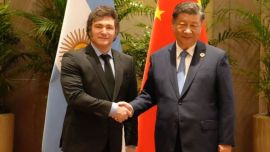Talks between the United States and China to resolve their year-long trade stand-off appeared to be on life-support Monday, with Beijing struggling to respond to tweets by US President Donald Trump that threaten an escalation of tariffs by the end of the week.
China’s Foreign Ministry said that officials were still planning to travel to the US for the next round of talks – but was unable to confirm when amid signs that a delay is now being considered. Meanwhile, a media black-out on Trump’s threat left investors baffled as stocks and the yuan tumbled on rumours that the trade war is now back on.
“We are now trying to get more information on the relevant situation,” Ministry spokesman Geng Shuang told a briefing in Beijing. “What I can tell you is that the Chinese team is preparing to travel to the US for trade talks.”
Trump on Sunday raised pressure on Beijing to strike a trade deal by announcing he would increase tariffs on US$200 billion of Chinese imports Friday to 25 percent from 10 percent. He also floated the possibility of extending a new 25 percent duty on another US$325 billion of imports not already covered.
Trump continued tweeting on the trade situation Monday. “The United States has been losing, for many years, 600 to 800 Billion Dollars a year on Trade. With China we lose 500 Billion Dollars. Sorry, we’re not going to be doing that anymore!” he wrote.
Escalating
“Risks of a full blown trade war are escalating,” Chua Hak Bin, a senior economist at Maybank Kim Eng Research Pte. in Singapore, said before the ministry’s announcement. “Trump’s threat may backfire as China will not want to negotiate with a gun pointing at their heads.”
Global equities tumbled and Treasury futures climbed on the news. The yuan slumped alongside crude oil. Futures on the S&P 500 Index sank as much as 2.2 percent, signalling a punishing start to the week on Wall Street, while European stocks slid and Chinese equities plunged.
China was considering delaying a US trip this week by a trade delegation led by Vice-Premier Liu He after Trump’s tariff threat, according people familiar with the matter. Liu and about 100 other officials had been scheduled to arrive Wednesday for what was shaping up to be the final round of negotiations.
It was unclear whether the threat reflected deeper concerns by Trump, who stunned North Korean leader Kim Jong-un by walking away from their nuclear summit in February, or a negotiating tactic. Washington had been targeting May 10 to announce a deal, that would be finalised and signed by Trump and Chinese President Xi Jinping later at an official summit, people familiar with the negotiations said last week.
The two sides have been locked in intense negotiations since last year for an agreement to address US concerns over China’s trade surplus, alleged theft of intellectual property and forced technology transfers. Trump and Xi agreed to a tariff truce on December 1 to allow senior officials time to negotiate.
The truce helped soothe investors concerns about a further escalation in a trade war between the world’s two largest economies, which imposed tariffs on about $360 billion of each other’s good last year. Trump’s latest tweets mark an abrupt reversal in stance for the White House after both sides had been saying for weeks that negotiations were going well.
Growing frustration
That shift reflects growing US frustration with China’s backpedalling on some of its earlier commitments, including on the crucial matter of technology transfer, two people familiar with the situation said. That’s emboldened trade hawks within the Trump administration to push for a harder line, including the raising of tariffs, the people said.
White House economic adviser Larry Kudlow said on Fox News that the president was “issuing a warning.” While “great progress” has been made in the talks, structural and enforcement issues remained, he said.
Trump imposed duties of 25 percent on an initial US$50 billion of Chinese goods last year and then 10 percent on an additional US$200 billion in products in September. Those duties were set to rise to 25 percent on January 1 and then again on March 1, but Trump delayed that as talks continued. China has imposed tariffs on US$110 billion of US exports in retaliation and repeatedly warned it would counter tariffs with actions of its own.
That means there’s a risk China would counter any extension of US levies, though the smaller size of its imports may constrain its ability to do so.
“China isn’t likely to make concessions that the US want with a big stick hanging over its head,” said Zhou Xiaoming, a former Ministry of Commerce official and diplomat. “If the tariffs that Trump threatens are implemented on Friday, China has to respond.”
Based on calculations by Bloomberg Economics, tariffs at the current level add up to a 0.5 percentage-point drag on China’s gross domestic product growth this year. An increase to 25 percent tariffs on US$200 billion in Chinese exports from 10 percent would raise the drag to 0.9 percentage point. Tariffs on all of China’s exports to the US would increase the burden to 1.5 point.
- Bloomberg
related news
by by Jenny Leonard, Steven Yang and Lucille Liu, Bloomberg
























Comments